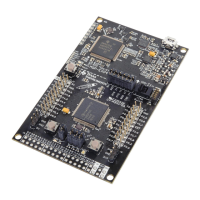GPIO
Description:
This function sets up the various interrupt trigger mechanisms for the specified pin(s) on the
selected GPIO port.
The parameter ui32IntType is an enumerated data type that can be one of the following values:
GPIO_FALLING_EDGE
GPIO_RISING_EDGE
GPIO_BOTH_EDGES
GPIO_LOW_LEVEL
GPIO_HIGH_LEVEL
where the different values describe the interrupt detection mechanism (edge or level) and the
particular triggering event (falling, rising, or both edges for edge detect, low or high for level
detect).
The pin(s) are specified using a bit-packed byte, where each bit that is set identifies the pin to
be accessed, and where bit 0 of the byte represents GPIO port pin 0, bit 1 represents GPIO
port pin 1, and so on.
Note:
In order to avoid any spurious interrupts, the user must ensure that the GPIO inputs remain
stable for the duration of this function.
Returns:
None.
10.2.1.9 ROM_GPIOPadConfigGet
Gets the pad configuration for a pin.
Prototype:
void
ROM_GPIOPadConfigGet(uint32_t ui32Port,
uint8_t ui8Pin,
uint32_t
*
pui32Strength,
uint32_t
*
pui32PinType)
ROM Location:
ROM_APITABLE is an array of pointers located at 0x0100.0010.
ROM_GPIOTABLE is an array of pointers located at ROM_APITABLE[4].
ROM_GPIOPadConfigGet is a function pointer located at ROM_GPIOTABLE[6].
Parameters:
ui32Port is the base address of the GPIO port.
ui8Pin is the pin number.
pui32Strength is a pointer to storage for the output drive strength.
pui32PinType is a pointer to storage for the output drive type.
Description:
This function gets the pad configuration for a specified pin on the selected GPIO port.
The values returned in pui32Strength and pui32PinType correspond to the values used in
ROM_GPIOPadConfigSet(). This function also works for pin(s) configured as input pin(s);
April 8, 2013 93

